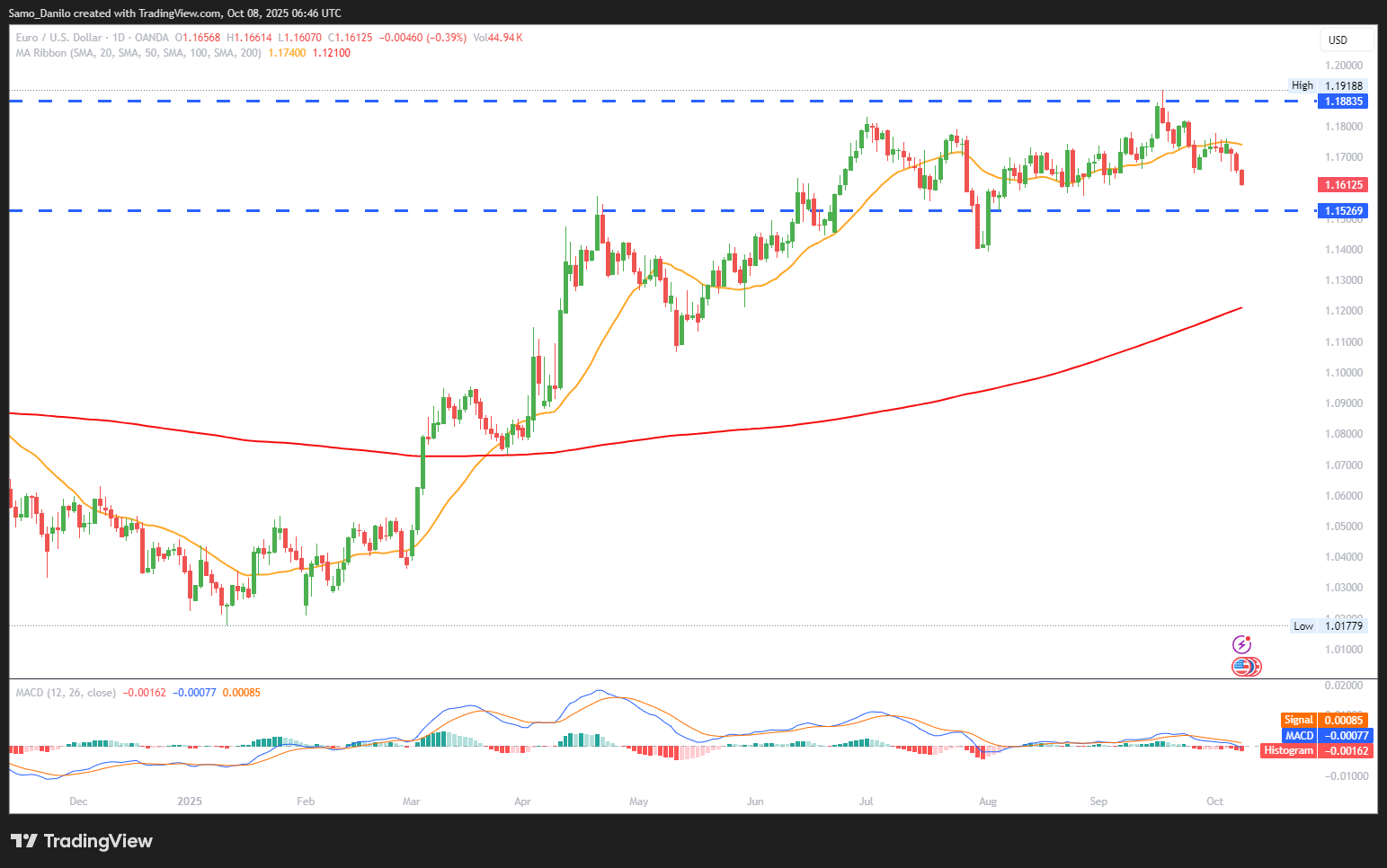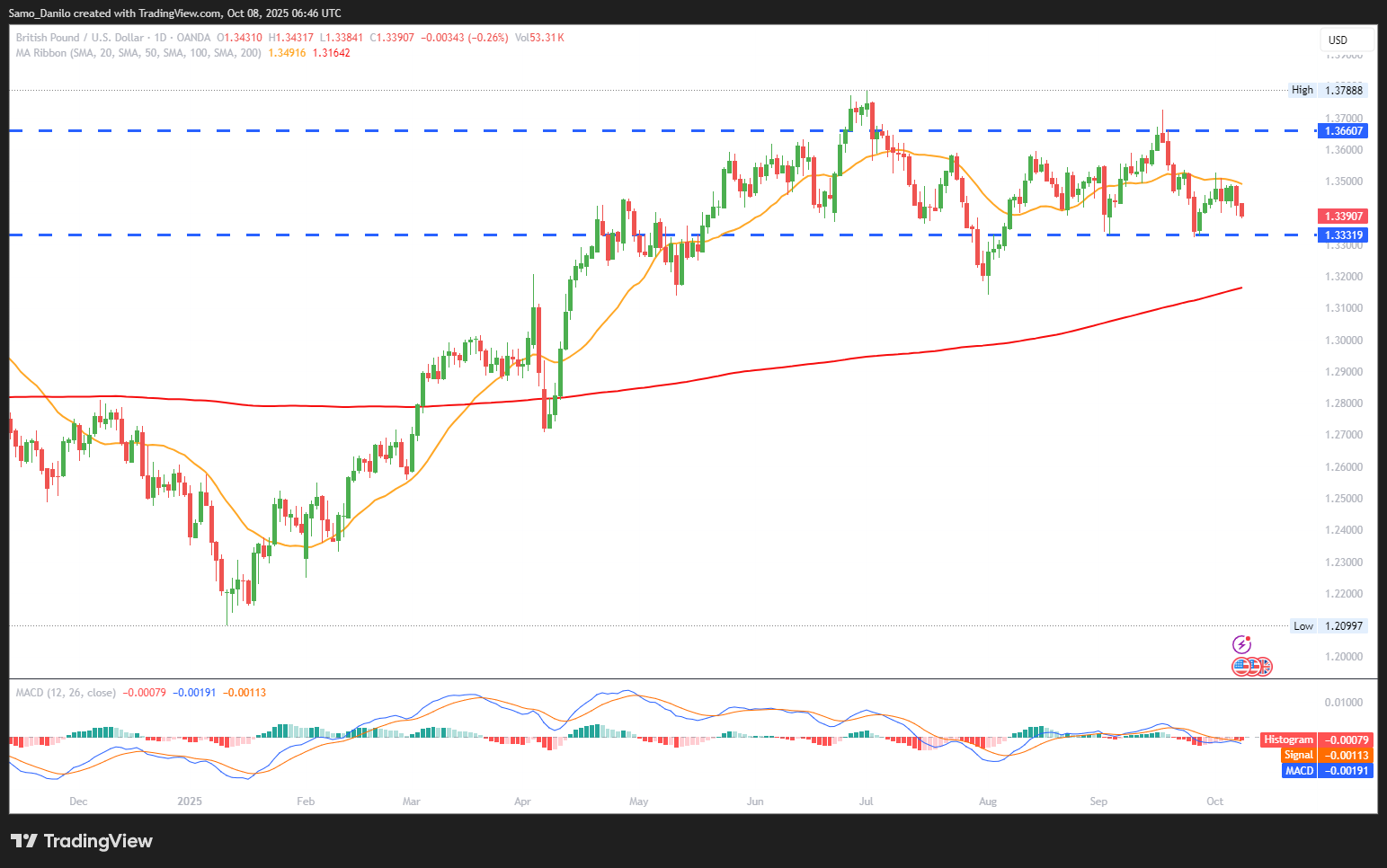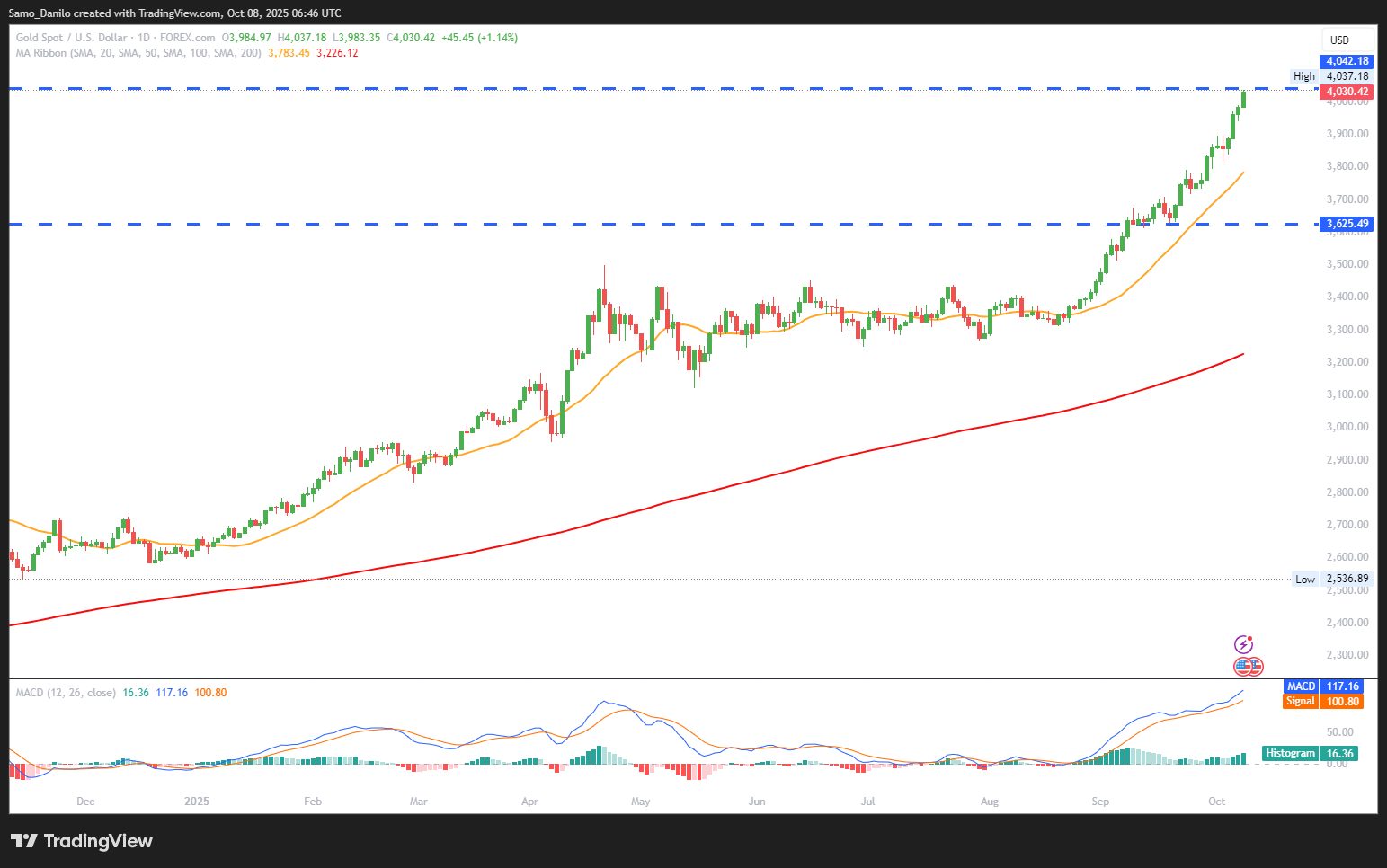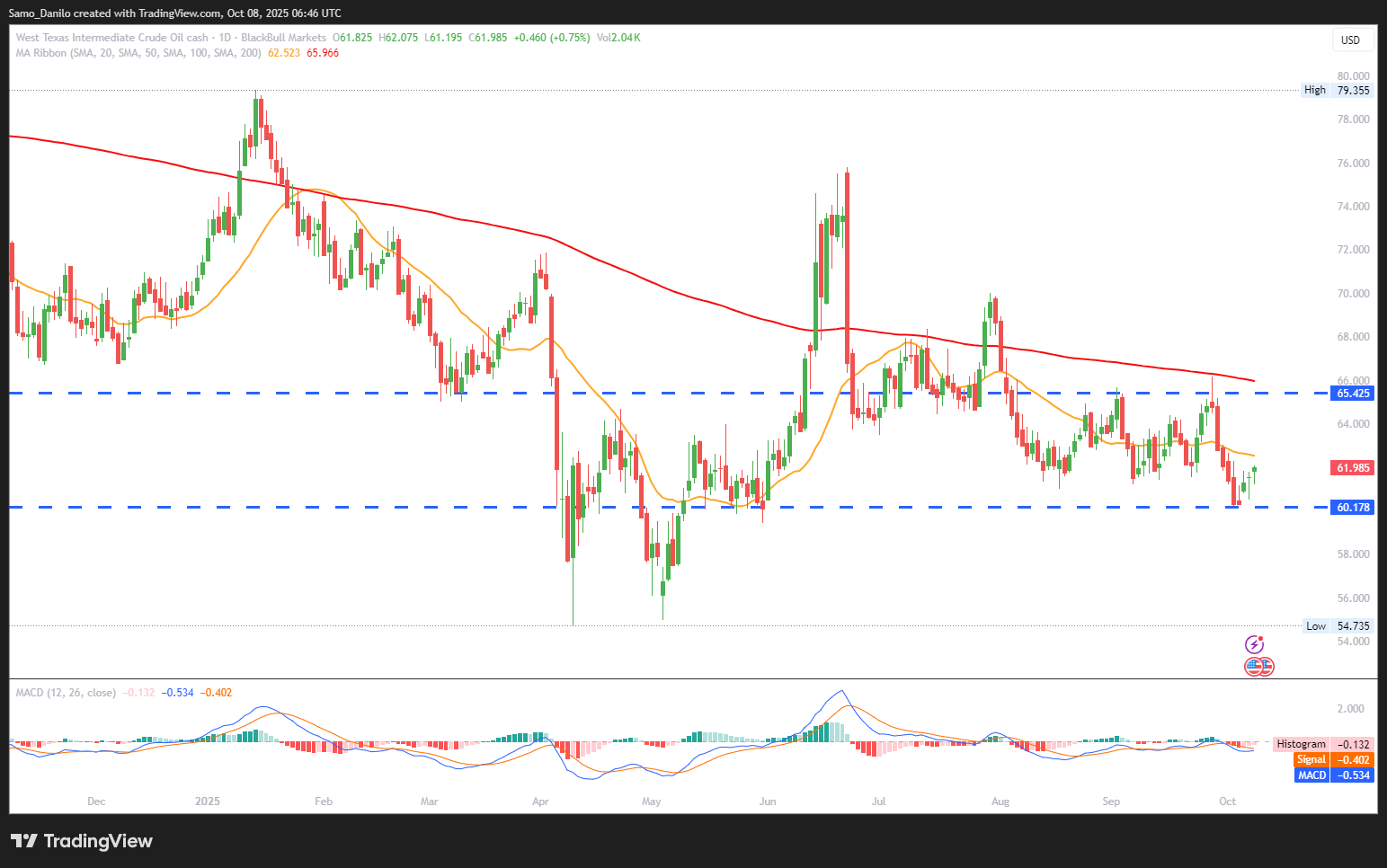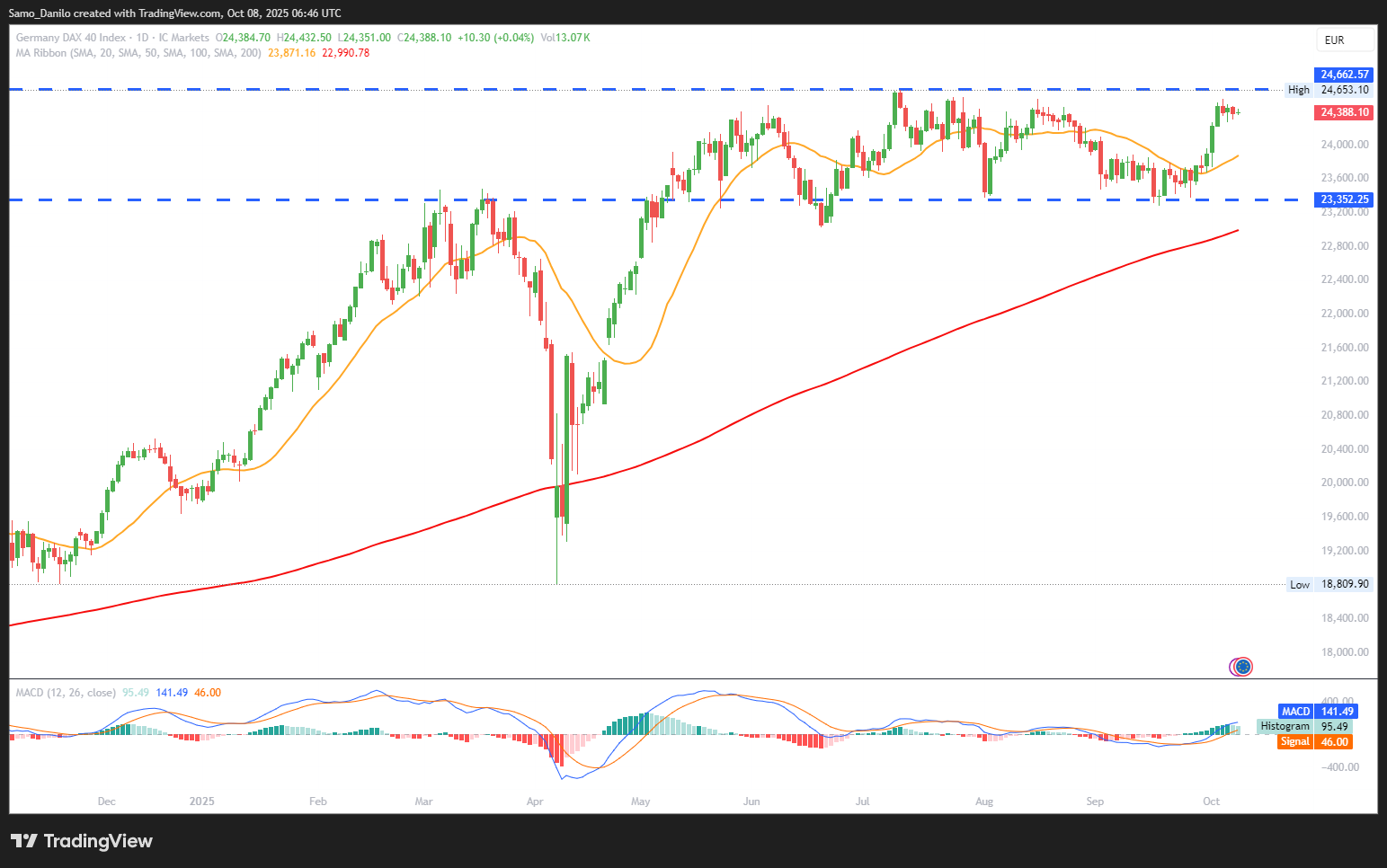EURUSD
- EUR/USD Price: The EUR/USD pair remains under pressure, trading near 1.1600, as persistent buying demand for the US Dollar keeps the euro on the defensive. The pair stays confined to the lower end of its recent range, reflecting cautious sentiment and a lack of fresh catalysts from Europe.
- Political Instability: The resignation of French Prime Minister Sébastien Lecornu underscores growing political fragility in France. President Emmanuel Macron’s isolation is deepening as former allies, including ex-Prime Minister Édouard Philippe, call for early elections, a move that could heighten policy uncertainty across the Eurozone.
- Fiscal Challenges: France continues to breach EU fiscal deficit and debt limits, with repeated reform attempts failing due to political resistance and social backlash. This ongoing fiscal instability is eroding investor confidence, weighing on broader Eurozone sentiment and the euro’s appeal.
- US Shutdown: Markets remain focused on Washington’s budget deadlock, with the US government shutdown now in its second week. While the USD has remained resilient so far, a prolonged closure could weaken the dollar, providing a potential rebound opportunity for EUR/USD.
- FOMC Minutes: Traders are awaiting the release of the Federal Open Market Committee (FOMC) September minutes for guidance on the timing and scope of future rate cuts. Any dovish signal could limit the USD’s advance and lend short-term support to the euro.
Closing statement: The EUR/USD outlook remains bearish near-term, dominated by dollar strength and European political uncertainty. However, a prolonged US shutdown or dovish Fed signals could offer temporary relief, allowing the pair to test higher resistance zones.
GBPUSD
- GBP/USD Price: The GBP/USD pair trades weaker, hovering near 1.3390 in early European hours on Wednesday. The pair continues to face headwinds from persistent dollar strength and a lack of domestic momentum, keeping sterling under pressure within a tight range.
- Business Sentiment: According to Reuters, UK businesses in the three months to September expect to maintain employment levels over the next year — marking the first pause in hiring optimism since January. This suggests slowing confidence in the UK’s economic outlook, reflecting caution amid elevated borrowing costs and tepid growth.
- Labour Market: Bank of America’s data indicated that the US labour market is cooling, with slower job growth and rising unemployment claims. However, wage growth remains uneven, with lower-income households lagging behind, a sign that inflationary pressures may persist but are losing breadth — a dynamic that supports the Fed’s cautious stance.
- BoE Guidance: Traders are awaiting Bank of England Chief Economist Huw Pill’s speech later today for potential clues on the UK rate outlook. Any dovish tone could further pressure the pound, while a hawkish surprise might help limit GBP/USD downside in the near term.
- Event Risk: In the US, the FOMC Minutes and multiple Federal Reserve speeches (including Barr, Goolsbee, Logan, and Kashkari) will be closely watched for policy direction. Any softening in tone could cap dollar gains, offering GBP/USD a chance to stabilize.
Closing statement: The GBP/USD outlook remains cautious, with sterling underperforming amid sluggish UK sentiment and resilient US data. The day’s tone will hinge on BoE communication and Fed commentary, which could either reinforce the pair’s downside bias or trigger short-term recovery toward the mid-1.34 region.
XAUUSD
- XAU/USD Price: Gold (XAU/USD) extended its bullish run, trading around $4,030 per ounce and setting a new all-time high. The rally reflects a combination of inflation concerns, central bank demand, and expectations of a dovish Fed shift later this month.
- US Inflation: The New York Fed’s SCE survey showed that inflation expectations ticked higher even as the labour market weakened further. This mix of rising inflation fears and slowing employment continues to support safe-haven assets like gold, as investors hedge against stagflation risks.
- Fed Commentary: Neel Kashkari of the Minneapolis Fed struck a moderately hawkish tone, warning it’s too early to tell if tariffs will make inflation sticky. His comments tempered some of the dovish market expectations but failed to significantly cool gold’s upward momentum.
- Chinese Demand: The People’s Bank of China (PBOC) increased its gold reserves for the 11th consecutive month, bringing holdings to 74.06 million ounces. Continuous accumulation underscores sustained institutional and sovereign demand, a major structural driver behind gold’s record levels.
- Market Expectations: Money markets now price in a 94% probability of a 25 bps rate cut at the October 29 FOMC meeting. Anticipation of easier policy continues to fuel demand for non-yielding assets such as gold, reinforcing the metal’s strong near-term outlook.
Closing statement: Gold’s trajectory remains strongly bullish, supported by central bank buying, rate cut expectations, and persistent inflation concerns. Unless the Fed pushes back decisively against market dovishness, XAU/USD could extend gains beyond $4,050, consolidating its position as the dominant safe-haven asset.
CRUDE OIL
- Crude Oil Price: West Texas Intermediate (WTI) extended its modest recovery, trading near $61.95 per barrel in early European hours, slightly up from Tuesday’s close at $61.74. The move reflects cautious optimism as supply dynamics shift and traders assess demand-side risks.
- OPEC+ Production: OPEC+ approved a smaller-than-expected output increase of 137,000 barrels per day (bpd) for November, below the anticipated 500,000 bpd rise. The limited adjustment helped ease oversupply concerns and provided near-term price support amid an uncertain demand outlook.
- Inventory Data: The API weekly report showed a 2.78 million barrel build in US crude stocks for the week ending October 3, contrasting with the 3.67 million barrel draw from the prior week. The unexpected increase in inventories tempered bullish sentiment, suggesting demand remains patchy.
- Monetary Outlook: Fed Governor Stephen Miran remarked that economic growth in early 2025 was weaker than anticipated, emphasizing the need for forward-looking policy due to lag effects. His comments reinforced expectations of a gradual easing cycle, indirectly supporting oil by weakening the dollar.
- Data Ahead: Traders now await the EIA’s official inventory report, due later on Wednesday, for confirmation of the API figures. The report is expected to set the tone for short-term direction, as markets gauge whether the recent inventory build is temporary or part of a broader trend.
Closing statement: WTI prices remain range-bound but slightly bullish, supported by a measured OPEC+ output hike and Fed-driven dollar softness. However, rising US inventories may cap gains unless the EIA data show a reversal, keeping crude in a fragile balance between supply restraint and demand uncertainty.
DAX
- DAX Price: The DAX remains range-bound, trading between 24,250 and 24,500 points since Thursday, reflecting stagnation at high levels. Investor sentiment appears cautious amid mixed economic and geopolitical signals.
- Industrial Data: Germany’s industrial output fell sharply by 4.3% in August, well below expectations of a 1% decline and a 1.3% rise in July, according to Destatis. The steep contraction highlights weakness in the industrial sector and potential headwinds for Eurozone growth.
- Trade Tariffs: US President Trump announced a 25% tariff on all medium and heavy-duty trucks imported into the US, effective November 1.
- EU Tariff: The EU plans 50% tariffs on steel imports exceeding 2013 quota levels, indicating escalating trade tensions that could influence European exporters.
- Geopolitical Developments: Trump stated that a Gaza peace deal is close, with Turkey, Iran, and Jordan expressing support. Egyptian media reported the negotiations ended “positively,” providing some geopolitical relief for markets sensitive to Middle East risks.
Closing statement: The DAX is trading cautiously within a narrow range, balancing strong geopolitical signals against weak domestic industrial activity and ongoing trade tensions. The index’s near-term direction will likely depend on incoming economic data and geopolitical developments.
